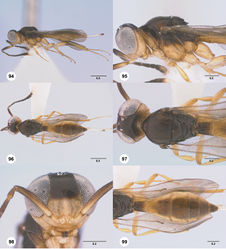Calliscelio eboris
| Notice: | This page is derived from the original publication listed below, whose author(s) should always be credited. Further contributors may edit and improve the content of this page and, consequently, need to be credited as well (see page history). Any assessment of factual correctness requires a careful review of the original article as well as of subsequent contributions.
If you are uncertain whether your planned contribution is correct or not, we suggest that you use the associated discussion page instead of editing the page directly. This page should be cited as follows (rationale):
Citation formats to copy and paste
BibTeX: @article{Chen2017ZooKeys, RIS/ Endnote: TY - JOUR Wikipedia/ Citizendium: <ref name="Chen2017ZooKeys">{{Citation See also the citation download page at the journal. |
Ordo: Hymenoptera
Familia: Platygastridae
Genus: Calliscelio
Name
Calliscelio eboris Chen & Johnson sp. n. – Wikispecies link – ZooBank link – Pensoft Profile
Description
Body length of female: 1.83–2.27 mm (n=20). Body length of male: 1.94–2.19 mm (n=20). Color of head: variably pale yellow to brown; reddish orange throughout. Color of antennal clava (A7–A12): A7–A9 brown, A10–A12 white; A7 brown, remainder orange. Shape of head: subglobose. Central keel of frons: present. Setation of upper frons: with sparse, long setae. IOS/EH: IOS distinctly less than EH. Sculpture of ventrolateral frons: smooth to coriaceous. Sculpture of frons below median ocellus: coriaceous. Sculpture of posterior vertex: transversely striate. Hyperoccipital carina: present. Occipital carina medially: interrupted. Length of OOL: less than 0.5× ocellar diameter. Sculpture of postgena behind outer orbit: smooth. Ocular setae: absent. A4 in female: as long as A3. A5 in female: shorter than A3, distinctly longer than wide. Shape of female A6: as long as wide. Form of male antennal flagellomeres: filiform, A11 approximately 3.0× longer than wide. Length of A5 tyloid in male: greater than 0.5× length of A5.
Color of mesosoma in female: variably yellow to pale brown; reddish orange throughout. Color of mesosoma in male: orange throughout; variably orange to pale brown. Sculpture of dorsal pronotal area: rugose. Sculpture of lateral pronotal area: smooth throughout. Sculpture of netrion: smooth. Notaulus: percurrent or nearly so. Sculpture of mesoscutum: coriaceous. Shape of mesoscutellum: semiellipsoidal. Foveolae of scutoscutellar sulcus between notauli: as large as those along margin of axilla. Sculpture of mesoscutellum: smooth with sparse fine punctures. Shape of metascutellum: posterior margin rounded, approximately 3.0× wider than long. Sculpture of metascutellum in female: smooth with a longitudinal, median carina. Sculpture of metascutellum in male: smooth with longitudinal, median carina. Dorsal propodeum in female: not excavate medially, lateral propodeal carinae meeting anteromedially. Sculpture of dorsal propodeum in female: rugose with one or two longitudinal keels lateral median keel. Sculpture of dorsal propodeum in male: rugose with one or two longitudinal keels lateral median keel. Median keels on propodeum in female: absent. Mesopleural carina: present. Sculpture of mesepisternum below mesopleural depression: smooth. Sculpture of ventral metapleural area: largely smooth, rugose ventrally. Color of legs: orange throughout; pale yellow throughout. Sculpture of hind coxa: smooth.
Color of fore wing: hyaline. Rs+M: spectral. Setae on R: short, decumbent, hardly exceeding the margin of the wing. Length of R: distinctly shorter than r-rs. Length of R1: greater than 3.0× length of r-rs.
Color of metasoma in female: orange throughout; variably orange to pale brown. Color of metasoma in male: variably orange to pale brown. Horn on T1 in female: absent. Sculpture of posterior margin of T1 in female: longitudinally striate throughout. Sculpture of T1 in male: longitudinally striate. Development of longitudinal striae on T2 in female: reaching the middle of T2 medially. Sculpture of T3: smooth. Shape of T6 in female: short, wider than long. Sculpture of S3: smooth.
Diagnosis
This species is most similar to Calliscelio brachys and Calliscelio suni. It can be separated from Calliscelio brachys by the percurrent notaulus, and from Calliscelio suni by the spectral Rs+M and the presence of a central keel on the frons.
Etymology
The epithet is used as a noun in apposition derived from the Latin word for ivory, in reference to the white A11–A12 of the female antennae.
Link to distribution map
[http://hol.osu.edu/map-full.html?id=384800]
Material examined
Holotype, female: COLOMBIA: Amazonas Dept., Amacayacu Natural N.P., M.84, 150m, 03°41'S 70°15'W, Matamata, 6.IV–15.IV.2000, Malaise trap, A. Parente, OSUC 193404 (deposited in IAVH). Paratypes: (58 females, 26 males) BOLIVIA: 12 females, 5 males, OSUC 534030, 534150–534151, 534156–534157, 534166–534171, 534173–534176, 534178–534179 (CNCI). COLOMBIA: 30 females, 19 males, OSUC 557578–557580 (CNCI); OSUC 143977, 152163, 152166, 162512, 162608, 176895, 189272, 193278, 193324–193325, 193327, 193424, 193461, 193932, 269448, 274572, 276241 (IAVH); OSUC 152164, 182227, 182485, 182492–182493, 182496, 182591, 182718–182720, 182733, 188948, 188959, 188962, 189175, 189205, 189216, 189275, 189283, 189290, 190305–190306, 192356, 193583, 193600, 231804, 231821, 272090, 279658 (OSUC). PERU: 11 females, 2 males, OSUC 553953, 553956, 553965, 554055–554064 (CNCI). VENEZUELA: 5 females, OSUC 223877–223881 (USNM).
Original Description
- Chen, H; Masner, L; Johnson, N; 2017: New World species of the genus Calliscelio Ashmead (Hymenoptera, Platygastridae, Scelioninae) ZooKeys, (648): 1-136. doi
Images
|
